Lhasa Tourism offers an unparalleled cultural and spiritual journey. SIXT.VN provides seamless travel solutions, ensuring an unforgettable experience in this mystical city with travel tips, cultural experiences, and practical advice. Discover Lhasa with confidence and convenience, unlocking the wonders of Tibet, exploring Himalayan adventures and embracing unique traditions.
1. When is the Best Time for Lhasa Tourism? Can You Visit Lhasa in Winter?
Lhasa is accessible year-round, and winter offers unique advantages. Known as the “City of Sunshine,” Lhasa enjoys over 8 hours of daily sunshine throughout the year. Winter in Lhasa features dry, sunny weather with average temperatures of 7-9°C (45-48°F).
Winter travel provides tranquility, authenticity, and cost savings. Fewer tourists mean a more serene experience, and many hotels and attractions offer off-peak discounts. Moreover, December is excellent for bird watching with ample sunshine and unfrozen lakes.
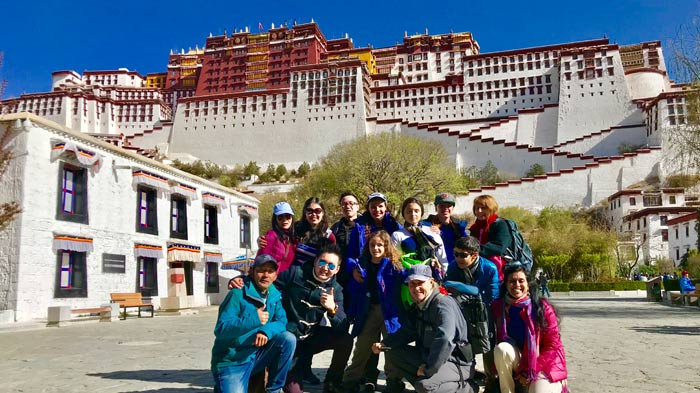 Winter view of Potala Palace, Lhasa, showcasing clear skies and architectural beauty
Winter view of Potala Palace, Lhasa, showcasing clear skies and architectural beauty
1.1. Optimal Seasons for Lhasa Tourism: April to June and September to October
Spring and autumn are ideal for Lhasa tourism due to clearer skies and mild temperatures. These seasons are perfect for trekking, such as the Ganden Monastery to Samye Monastery trek, offering stunning views of the Nyenchen Tanglha Mountains. The absence of rainfall and comfortable temperatures make these months the best for outdoor activities.
1.2. Peak Season for Lhasa Tourism: July and August
Summer is the busiest tourist season in Lhasa, with warmer temperatures reaching 23-25°C (73-77°F) during the day. While nights can be cool, the weather is generally pleasant. Summer is also monsoon season, with rains typically occurring in the late evenings and overnight, leaving daytime clear for sightseeing. However, be prepared for higher prices due to increased tourist traffic.
2. Can You Explore Lhasa City Independently?
Currently, independent exploration of Lhasa, especially at tourist sites like Potala Palace and Jokhang Temple, requires a licensed tour guide. According to the Tibet Tourism Bureau, guides ensure the preservation of cultural sites and provide accurate information.
Employing a local guide enhances your experience, breaking language barriers and offering insights into the history and culture of monasteries. Moreover, local guides provide authentic experiences, such as enjoying sweet tea in traditional tea houses and exploring hidden gems.
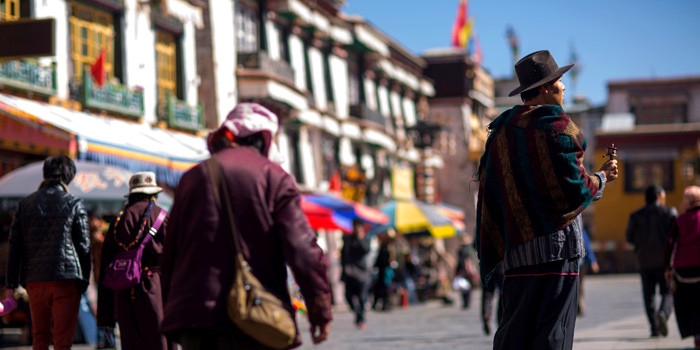 A guided tour group exploring the Barkhor Street in Lhasa, highlighting the cultural richness and local experience
A guided tour group exploring the Barkhor Street in Lhasa, highlighting the cultural richness and local experience
3. Beyond Potala Palace: What Other Beauty Spots Does Lhasa Offer?
Lhasa offers numerous attractions beyond the well-known Potala Palace, Jokhang Temple, and Barkhor Street. A classic Lhasa trip typically includes these sites plus Sera and Drepung Monasteries. However, with extra time, consider these additions:
3.1. One-Day Trek from Pabonka to Pubjoi Monastery
This trek explores lesser-known Buddhist heritage sites outside Lhasa. Starting at Pabonka, a cliff-side palace, the route ascends to Tashi Chöling and Tagden Ritro, then descends to Sera Ütse, Raka Drak, and Purbu Jog Monastery. This trek requires acclimatization due to the altitude.
3.2. One-Day Kora Around Ganden Monastery
The kora (pilgrimage circuit) around Ganden Monastery provides stunning views of Lhasa Valley and the Nyenchen Tanglha mountain range. This trek, at around 4,300 meters (14,100 feet), requires acclimatization and physical fitness. The route includes high and low kora sections, each offering unique perspectives.
3.3. One-Day Tour to Yamdrok Lake
Yamdrok Lake, one of Tibet’s Great Three holy lakes, is surrounded by snow-capped mountains, with Mount Nyenchen Khangsar towering at 7,191 meters (23,593 feet). The journey includes conquering Gangbala Pass (5,030 meters/16,500 feet) for photo opportunities and leisurely walks along the lakeshore.
3.4. Two-Day Visit to Samye Monastery
Samye Monastery, Tibet’s first Buddhist monastery, was built in the 8th century and designed as a giant mandala. Explore the distinctive spiritual ambiance and, if time allows, hike up Hepori Hill for a panoramic view. According to historical records, Samye Monastery was a pivotal center for the propagation of Buddhism in Tibet.
3.5. Two-Day Trip to Lake Namtso
Lake Namtso, a sapphire on the plateau, offers breathtaking views of snow-covered Nyenchen Tanglha Mountains and Tibetan nomads’ tents. On the return to Lhasa, relax in the Yangbajing hot springs. The Qinghai-Tibet Railway offers convenient access, making it a memorable addition to your Lhasa tour.
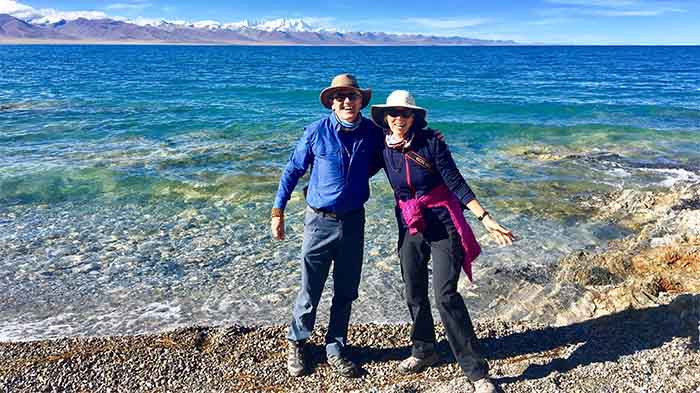 The serene beauty of Namtso Lake, reflecting the clear sky and surrounding mountains, inviting visitors to experience its tranquility
The serene beauty of Namtso Lake, reflecting the clear sky and surrounding mountains, inviting visitors to experience its tranquility
4. Are Tibetan-Style Hotels the Only Accommodation Option?
Lhasa offers a range of accommodation options to suit every traveler’s needs. According to Booking.com, Lhasa provides everything from five-star resorts like St Regis Lhasa Resort to budget-friendly guesthouses.
High-end hotels offer luxury and comfort, while smaller hotels and hostels provide affordable options for budget travelers. The variety ensures that every visitor can find suitable lodging.
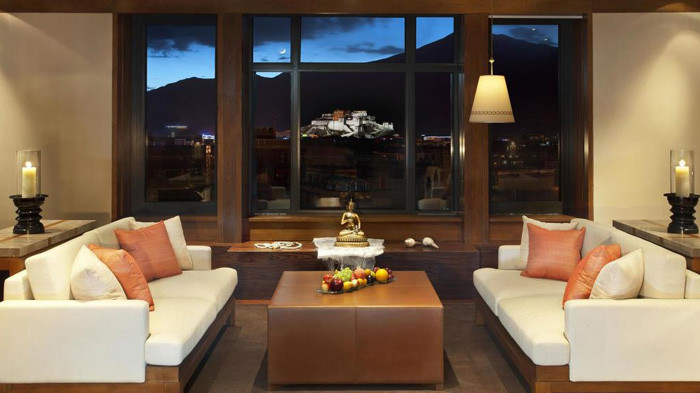 The luxurious St. Regis Lhasa Resort, offering a blend of modern comfort and traditional Tibetan design
The luxurious St. Regis Lhasa Resort, offering a blend of modern comfort and traditional Tibetan design
5. Can You Find Non-Tibetan Food in Lhasa?
Lhasa’s culinary scene is diverse, catering to international tourists with various food choices. Western dishes like pasta and pizza are available in hotels and large restaurants, while Sichuan spicy flavors, Indian, and Nepalese curries are also common.
Vegan options are increasingly available, and your guide can recommend restaurants that match your taste. The fusion of Tibetan and international cuisines ensures a satisfying dining experience for every visitor.
6. What Should You Pack for a Visit to Lhasa?
Packing for Lhasa depends on the season and your itinerary. Summer requires lighter clothing, with a raincoat for possible showers. Winter demands warm clothing, including thick sweaters, down jackets, and warm shoes.
Regardless of the season, bring sturdy boots for walking on uneven terrain, especially when visiting sites like Lake Namtso. Trekking requires waterproof pants, layered clothing, a hat, and sunglasses. A small daypack is essential for carrying documents, snacks, and water.
7. How Accessible is Lhasa? What Are the Transportation Options?
Lhasa is easily accessible by plane, train, or overland routes.
7.1. Flights to Lhasa
Flying to Lhasa is fast but doesn’t allow for altitude acclimatization. Airfares can be high due to demand, so book in advance. Numerous airlines offer routes from major Chinese cities, making it a convenient option for international travelers.
7.2. Trains to Lhasa
The Tibet train offers spectacular views, traveling across China to the Tanggula Mountains. The journey takes 22-55 hours, providing breathtaking scenery. According to the China Railway Corporation, the Qinghai-Tibet Railway is an engineering marvel, offering a unique travel experience.
7.3. Overland Tours to Lhasa
Overland tours offer adventure through scenic routes like the Sino-Nepal Friendship Highway and the Sichuan-Tibet Highway. The overland tour between Lhasa and Kathmandu is popular, crossing Gyirong Valley and Everest Base Camp. These routes provide immersive cultural and landscape experiences.
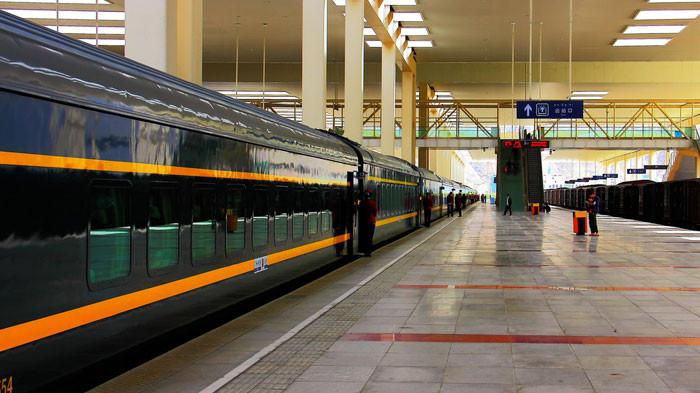 The Tibet Train winding through the scenic landscapes, offering a unique travel experience to Lhasa
The Tibet Train winding through the scenic landscapes, offering a unique travel experience to Lhasa
8. Can You Visit Everest Base Camp Directly From Lhasa?
Acclimatization in Lhasa is crucial before heading to Everest Base Camp (EBC). Lhasa has an altitude of 3,656 meters (12,000 feet), while EBC is at 5,200 meters (17,000 feet). A sudden elevation increase can cause altitude sickness, so spend at least three days in Lhasa to adjust.
Avoid showering on your first day to prevent catching a cold, rest, and avoid strenuous exercise. Minimize oxygen use to encourage your body’s natural acclimatization process. Gradual adjustment ensures a safer and more enjoyable journey to EBC.
9. Why Book Lhasa Tours With a Tibetan Travel Agency?
Booking with a local Tibetan travel agency offers several advantages. These agencies provide Tibetan guides who offer authentic cultural insights and local customs. According to the Tibet Tourism Association, local guides enhance the travel experience by sharing their deep knowledge and personal stories.
Local tour operators also offer reasonable prices without middleman commissions, ensuring better value for your money. They can also arrange permits and navigate local regulations, simplifying your travel process.
10. Do You Need to Wear a Mask in Lhasa?
Masks are recommended in Lhasa, especially in tourist attractions, public transport, and public zones. Temperature checks are required before entering major sights. Masks protect against viruses, strong sunrays, wind, and dust. Even without COVID-19, locals often wear masks daily.
11. What are the Benefits of Using SIXT.VN for Lhasa Tourism?
SIXT.VN offers several key benefits for tourists planning a trip to Lhasa:
- Convenient Travel Solutions: SIXT.VN provides comprehensive services including airport transfers, hotel bookings, and tour packages tailored to your needs.
- Expert Local Guidance: Access to knowledgeable local guides who can offer insights into Tibetan culture and history.
- Reliable and Trustworthy: SIXT.VN ensures reliable and trustworthy services, simplifying your travel planning and ensuring a smooth experience.
- Customized Itineraries: Tailored itineraries to suit your preferences, whether you’re interested in cultural sites, trekking, or exploring remote lakes.
- 24/7 Support: Round-the-clock customer support to assist with any issues or queries during your trip.
12. What are the Key Attractions to Visit in Lhasa?
Lhasa boasts a plethora of attractions that cater to various interests. Here’s a list of must-visit sites:
| Attraction | Description |
|---|---|
| Potala Palace | The winter palace of the Dalai Lamas, an iconic symbol of Tibet, offering stunning views and rich history. |
| Jokhang Temple | The most sacred temple in Tibet, housing the Jowo Shakyamuni statue, attracting pilgrims from across the region. |
| Barkhor Street | A bustling market street surrounding Jokhang Temple, perfect for experiencing local culture and shopping for souvenirs. |
| Sera Monastery | Famous for its lively monk debates held in the courtyard, providing insight into Tibetan Buddhist philosophy. |
| Drepung Monastery | Once the largest monastery in the world, now a significant Buddhist learning center with beautiful architecture and serene surroundings. |
| Norbulingka | The summer palace of the Dalai Lamas, a beautiful park with palaces, gardens, and cultural relics. |
| Yamdrok Lake | One of the Great Three holy lakes, known for its stunning turquoise waters and breathtaking mountain scenery. |
| Ganden Monastery | One of the Great Three Gelug monasteries, offering panoramic views of the Lhasa Valley and surrounding mountains. |
| Lake Namtso | The highest saltwater lake in the world, offering stunning views of the snow-capped Nyenchen Tanglha Mountains and nomadic landscapes. |
| Samye Monastery | The first Buddhist monastery in Tibet, designed as a giant mandala, known for its unique architecture and spiritual significance. |
| Pabonka Monastery | One of the oldest Buddhist sites in the Lhasa area, offering a peaceful retreat and historical insights. |
| Drak Yerpa | A series of ancient meditation caves carved into the mountainside, offering a spiritual and adventurous experience. |
| Lhasa Museum | Showcasing Tibetan art, history, and culture, providing a comprehensive overview of the region’s heritage. |
| Tromzikhang Market | A local market where you can experience the everyday life of Lhasa residents and find various local products and goods. |
13. What Cultural Etiquette Should Tourists Know When Visiting Lhasa?
Respecting local customs and traditions is crucial for a meaningful visit to Lhasa. Here are some key etiquette points to remember:
| Etiquette Topic | Guidelines |
|---|---|
| Dress Code | Dress modestly, avoiding revealing clothing. Long sleeves and pants or skirts are recommended when visiting monasteries and temples. |
| Entering Temples | Remove hats and sunglasses before entering temples. Avoid stepping on the threshold and be mindful of where you point your feet. |
| Photography | Ask for permission before taking photos of people, especially monks and nuns. Some temples may prohibit photography inside. |
| Offering | When visiting temples, consider making a small donation. It is a sign of respect and supports the upkeep of the sacred sites. |
| Talking | Avoid loud or disruptive behavior in temples and monasteries. Speak in a respectful and quiet tone. |
| Circumambulation | When walking around temples and other sacred sites (kora), always walk in a clockwise direction. |
| Gestures | Avoid pointing fingers or feet at religious objects or people. Use your whole hand when offering or receiving items. |
| Interaction with Monks | Show respect to monks and nuns. Avoid touching them without permission and use formal greetings such as “Tashi Delek” (good luck) when interacting with them. |
| Food and Drink | When invited to a local’s home, accept food and drink offerings with gratitude. It is polite to take a small amount initially and ask for more if desired. |
| General Conduct | Be mindful of your actions in public spaces. Avoid public displays of affection and refrain from discussing sensitive political topics. |
| Bargaining | Bargaining is acceptable in markets, but always do so respectfully and with a smile. Avoid aggressive bargaining. |
14. How Can SIXT.VN Help with Booking Accommodation in Lhasa?
SIXT.VN simplifies the process of finding the perfect accommodation in Lhasa. Here’s how:
- Wide Range of Options: SIXT.VN offers a curated selection of hotels, guesthouses, and resorts in Lhasa, catering to different budgets and preferences.
- Detailed Information: Access comprehensive details about each property, including photos, amenities, guest reviews, and location information.
- User-Friendly Booking Process: The intuitive platform allows you to easily filter options based on your criteria, compare prices, and book your preferred accommodation securely.
- Local Expertise: Benefit from local expertise and recommendations, ensuring you choose a property that meets your specific needs and offers a comfortable stay.
- Exclusive Deals: Take advantage of exclusive deals and discounts available through SIXT.VN, making your Lhasa trip more affordable.
15. What Activities Can SIXT.VN Arrange for Tourists in Lhasa?
SIXT.VN can arrange a wide range of activities to enrich your Lhasa experience:
| Activity | Description |
|---|---|
| Guided Tours | Professional guides lead you through Lhasa’s cultural and historical sites, providing in-depth insights and enriching your understanding. |
| Monastery Visits | Arrange visits to renowned monasteries like Sera, Drepung, and Ganden, with opportunities to witness monk debates and learn about Tibetan Buddhism. |
| Trekking Excursions | Organize trekking adventures to places like Pabonka Monastery and Ganden Monastery, offering stunning views and unique cultural experiences. |
| Lake Tours | Plan day trips or multi-day excursions to the sacred lakes of Yamdrok and Namtso, complete with comfortable transportation and expert guidance. |
| Cultural Experiences | Immerse yourself in local culture with activities such as attending Tibetan opera performances, visiting local markets, and participating in traditional festivals. |
| Transportation | Arrange comfortable and reliable transportation, including airport transfers, private car services, and overland journeys to remote destinations. |
| Permit Assistance | Assist with obtaining the necessary travel permits for Tibet, ensuring a smooth and hassle-free travel experience. |
| Customizable Itineraries | Create personalized itineraries based on your interests, whether you’re passionate about culture, adventure, or relaxation. |
| Photography Tours | Arrange specialized photography tours led by experienced photographers, capturing the stunning landscapes and cultural highlights of Lhasa. |
| Culinary Experiences | Discover the flavors of Tibetan cuisine with guided culinary tours and cooking classes, offering a hands-on experience of local gastronomy. |
16. What are Some Common Misconceptions About Visiting Lhasa?
Several misconceptions can deter potential visitors from exploring Lhasa. Addressing these can help travelers make informed decisions:
| Misconception | Reality |
|---|---|
| It’s too cold to visit. | Lhasa enjoys a mild climate with plenty of sunshine, even in winter. While nights can be cold, daytime temperatures are often comfortable. |
| It’s difficult to acclimatize. | While altitude sickness is a concern, most visitors can acclimatize with a few days of rest and hydration. Avoid strenuous activities and alcohol upon arrival. |
| It’s too expensive. | Lhasa offers a range of accommodation and dining options to suit different budgets. Traveling during the off-season can also significantly reduce costs. |
| It’s unsafe for tourists. | Lhasa is generally a safe destination for tourists. However, it’s important to be aware of your surroundings and follow local guidelines. |
| There’s nothing to do but visit temples. | Lhasa offers a wide range of activities, including trekking, lake tours, cultural performances, and culinary experiences. The city provides a diverse and enriching travel experience. |
| You need to be a seasoned traveler. | Lhasa is accessible to travelers of all levels. With proper planning and preparation, anyone can enjoy a memorable trip. Booking with a reputable agency like SIXT.VN can simplify the process and ensure a smooth experience. |
| You can only visit with a group tour. | While independent travel is restricted, you can still explore with a private tour guide, giving you flexibility and personalized attention. |
| It’s culturally insensitive to visit. | Respectful and informed tourism can positively contribute to the local economy and cultural preservation. Following local etiquette guidelines ensures a meaningful and responsible travel experience. |
17. What Safety Measures Should Tourists Take in Lhasa?
Ensuring your safety is paramount when visiting Lhasa. Here are some key safety measures to consider:
| Safety Topic | Recommendations |
|---|---|
| Altitude Sickness | Acclimatize gradually by spending a few days in Lhasa before engaging in strenuous activities. Stay hydrated, avoid alcohol, and consult a doctor about altitude sickness medication. |
| Health Precautions | Consult your doctor about necessary vaccinations and health precautions before traveling. Bring a basic first-aid kit with essentials like pain relievers, antiseptic wipes, and bandages. |
| Food and Water Safety | Drink bottled water and avoid consuming raw or undercooked foods. Choose reputable restaurants and food stalls. |
| Weather Conditions | Be prepared for varying weather conditions, especially if trekking or visiting high-altitude lakes. Pack layers of clothing, including waterproof and windproof gear. |
| Traffic Safety | Be cautious when crossing streets and navigating traffic. Use designated crosswalks and follow local traffic rules. |
| Personal Belongings | Keep your personal belongings secure and avoid displaying valuable items in public. Be aware of pickpockets and petty theft, especially in crowded areas. |
| Emergency Contacts | Keep a list of emergency contacts, including local police, embassy or consulate, and your tour operator. Share your itinerary with family or friends. |
| Cultural Sensitivity | Respect local customs and traditions. Dress modestly, ask for permission before taking photos, and avoid discussing sensitive political topics. |
| Travel Insurance | Purchase comprehensive travel insurance that covers medical emergencies, trip cancellations, and loss of personal belongings. |
| Local Regulations | Be aware of local regulations and guidelines, especially regarding restricted areas and travel permits. Follow the advice of your tour guide. |
18. How Does Lhasa Tourism Contribute to the Local Economy?
Lhasa tourism plays a significant role in supporting the local economy. Here’s how:
| Economic Impact | Description |
|---|---|
| Job Creation | Tourism creates numerous job opportunities for local residents in sectors such as hospitality, transportation, tour guiding, and handicrafts. |
| Income Generation | Tourism generates income for local businesses, including hotels, restaurants, shops, and tour operators, boosting the overall economy. |
| Infrastructure Development | Tourism drives investment in infrastructure development, such as roads, airports, and hotels, improving living standards for local communities. |
| Cultural Preservation | Tourism helps preserve Tibetan culture and traditions by providing incentives for local communities to maintain their heritage and showcase it to visitors. |
| Handicraft Industry | Tourism supports the local handicraft industry by providing a market for traditional Tibetan products such as thangkas, carpets, jewelry, and clothing, sustaining traditional skills and livelihoods. |
| Rural Development | Tourism can promote rural development by bringing income and opportunities to remote areas, encouraging sustainable tourism practices and reducing poverty. |
| Revenue for Local Government | Tourism generates revenue for local governments through taxes and fees, which can be used to fund public services and infrastructure projects. |
19. What Unique Souvenirs Can Tourists Buy in Lhasa?
Lhasa offers a variety of unique souvenirs that reflect the rich Tibetan culture and artistry. Here are some popular options:
| Souvenir | Description |
|---|---|
| Thangkas | Intricate Tibetan Buddhist paintings on cotton or silk, depicting deities, mandalas, and religious scenes. |
| Prayer Wheels | Cylindrical wheels containing mantras, spun to accumulate merit and spread blessings. |
| Tibetan Carpets | Hand-knotted wool carpets with traditional Tibetan designs, known for their durability and vibrant colors. |
| Turquoise Jewelry | Jewelry made from turquoise, a gemstone highly valued in Tibetan culture for its spiritual and protective qualities. |
| Incense | Tibetan incense made from natural herbs and resins, used for religious ceremonies and meditation. |
| Singing Bowls | Metal bowls that produce resonant tones when struck or rubbed, used for meditation and sound healing. |
| Prayer Flags | Colorful flags printed with prayers and mantras, hung to spread blessings with the wind. |
| Tibetan Clothing | Traditional Tibetan robes, vests, and hats made from wool and silk, often adorned with intricate embroidery. |
| Buddhist Statues | Statues of Buddha and other Buddhist deities, made from bronze, brass, or clay. |
| Local Handicrafts | Various local handicrafts such as wooden carvings, metalwork, and handmade paper products. |
| Tibetan Tea and Butter Tea | Traditional Tibetan teas and butter tea, along with the utensils used to prepare them, such as wooden churns and teapots. |
| Books and Manuscripts | Tibetan books, manuscripts, and religious texts, providing insights into Tibetan culture and Buddhism. |
20. What Future Trends Can Tourists Expect in Lhasa Tourism?
Lhasa tourism is continuously evolving to meet the changing needs and preferences of travelers. Here are some future trends to watch for:
| Trend | Description |
|---|---|
| Sustainable Tourism | Increased focus on sustainable tourism practices, with efforts to minimize environmental impact and support local communities. |
| Cultural Immersion | Growing demand for authentic cultural experiences, such as homestays, cooking classes, and participation in local festivals. |
| Adventure Tourism | Expansion of adventure tourism activities, including trekking, mountain biking, and rock climbing, catering to thrill-seekers. |
| Wellness Tourism | Rising interest in wellness tourism offerings such as meditation retreats, yoga classes, and traditional Tibetan medicine treatments. |
| Digitalization | Increased use of digital technologies to enhance the travel experience, including online booking platforms, mobile apps, and virtual tours. |
| Accessibility | Improved accessibility for travelers with disabilities, with efforts to make tourist sites and facilities more inclusive. |
| Ecotourism | Promotion of ecotourism initiatives, such as birdwatching tours and wildlife safaris, showcasing the region’s natural beauty. |
| Community-Based Tourism | Development of community-based tourism projects that empower local communities and provide economic benefits. |
| Customized Experiences | Growing trend towards personalized travel experiences, with tour operators offering customized itineraries tailored to individual preferences. |
Ready to embark on your Lhasa adventure? Let SIXT.VN handle the details. Contact us today at +84 986 244 358 or visit our website SIXT.VN to explore our Lhasa tour packages, book airport transfers, and find the perfect hotel for your unforgettable journey! Our address is 260 Cau Giay, Hanoi, Vietnam.
FAQ about Lhasa Tourism
Q1: Do I need a special permit to visit Lhasa?
Yes, you need a Tibet Travel Permit (TTP) to enter Lhasa. SIXT.VN can assist you in obtaining this permit.
Q2: What is the best way to acclimatize to the altitude in Lhasa?
Spend a few days resting, stay hydrated, and avoid strenuous activities upon arrival.
Q3: Can I travel to Lhasa independently?
Independent travel is restricted. You need to be part of an organized tour or have a private guide.
Q4: What is the local currency in Lhasa?
The local currency is the Chinese Yuan (CNY).
Q5: What language is spoken in Lhasa?
The primary languages are Tibetan and Mandarin Chinese.
Q6: Are credit cards widely accepted in Lhasa?
Credit cards are not widely accepted. It’s best to carry cash.
Q7: What is the time difference between Lhasa and GMT?
Lhasa is GMT+8, the same as Beijing.
Q8: Is it safe to drink tap water in Lhasa?
No, it is recommended to drink bottled water.
Q9: What is the best way to dress when visiting monasteries?
Dress modestly, covering shoulders and knees.
Q10: Can I take photos inside the Potala Palace?
Photography is restricted in certain areas. Check with your guide for specific rules.



